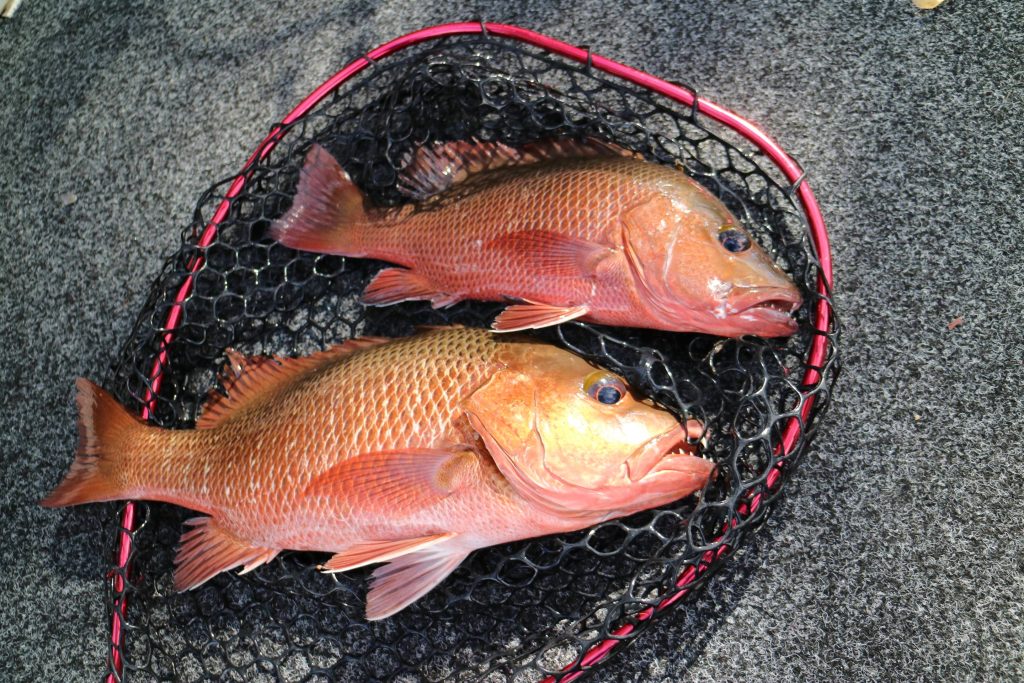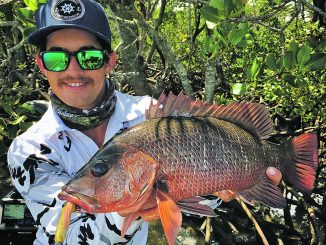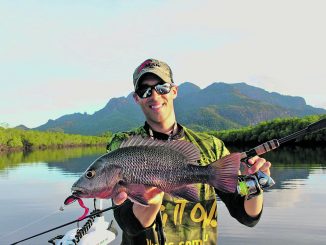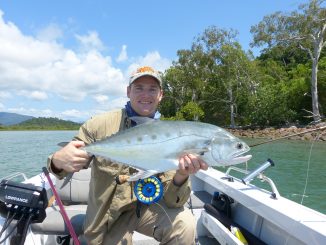
by Simon Goldsmith •
All too often overlooked by those favouring the Gold Coast, the Tweed River is a mangrove jack fishery that offers much and can deliver plenty for anglers looking for a jack hit.
This easy-to-access open waterway isn’t cluttered with 4 knot speed zones, and it has maze-like canal systems like the Gold Coast, which are easy to get lost in. The Tweed is a system that you can easily ‘run and gun’ on when it comes to locating active fish.
One of the Tweed’s other great assets is its habitat diversity, with rock bars, rock walls, bridges, timbered banks, and to a lesser degree canals, pontoons and oyster racks offering a host of holding locations for mangrove jack.
The Tweed is a river that offers the best of both worlds when it comes to jack fishing, and whether it’s natural or man-made structure that you like to target for your fish, the Tweed has it.
Click here for Gold Coast/Tweed fishing report
The Arena
A river that begins with its headwaters deep in the Tweed Valley and within sight of Mount Warning, it’s not unil you hit the upper saltwater limit at the weir at Bray Park near Murwillumbah that reliable jack water begins. From here, the river winds its way towards the ocean, passing through and past cane fields, residential areas, townships, rainforest, and mangrove stands.
The Tweed River meets the ocean at Point Danger and in its saltwater reaches is armed by a series of tributaries including the Rous River, Dunbibble Creek, Stotts Channel, Boyds Channel, Bilambil Creek, Cobaki Creek, Terranora Creek, and the Terranora and Cobaki broadwaters.
All of these locations have the potential of holding mangrove jack, with diversity in habitat type, water flow, temperature, and salinity delivering a host of variables that influence where and when you’ll find mangrove jack in residence at the location you’re fishing. Research, experience, time on the water, and hopefully some information in this article may help you pinpoint the most productive spots to target.
Autumn Action
Once we get to the tail end of summer and the early days of autumn, mangrove jack should be in full attack mode, with water temperatures at their highest, bait in abundance, and the metabolism of the fish at its highest during their peak season of activity.
These factors definitely play into the hands of the angler, but this time of the year also potentially offers some challenges, obstacles that you may need to overcome to catch a jack. So let’s take a look at the pros and cons of late jack hunting on the Tweed River.
It’s Coming Down
The most northern river in the Northern Rivers region, the Tweed River has a rich history of receiving plenty of rain and its fare share of floods, most of which fall during the late summer and early autumn period. For the jack angler this impact can range from a slight hiccup that’s an inconvenience, to writing off the season until next spring rolls around.
The Tweed has two main arms, the main arm that starts up in the Tweed Valley, and the shorter Terranora arm that joins the main river at Tweed Heads. The shorter arm, being the Terranora arm, provides a level of protection when the river experiences inflows and a flood, with most of the flow coming down the main river and out to sea, bypassing the Terranora as it goes.
The outcome often is higher water temperature and salinity levels in the Terranora than the main arm of the river, two factors that mangrove jacks generally like. Of course, not all rain and inflows are a bad thing, as with a touch of freshwater delivering an increased level of discoloration to the water, this can incite predatory fish to feed more aggressively and actively.
Freshwater inflows can also relocate and increase the movement of bait, and are two changes that can see mangrove jack focus their attention on specific areas and bait types. Prawns are a prime example of a species that can be flushed out and congregate in a specific area.
I remember a specific incident when I was fishing a shaded, timber-lined mangrove bank one afternoon and in front of me tight against the bank was a mangrove jack feeding with its dorsal fin out the water. It was locked in on the prawns that were abundant along the shoreline, and despite casting a host of different lures at it, none of which spooked the fish or incited a strike, the fish just kept feeding and only had eyes for the prawns in front of it. A prawn imitation lure or fly may have been the ticket to success on the day if I’d had one with me.
Watching, learning, and trial and error during times of fresh are the best ways to identify when and how these bait changes occur and the potential angling opportunities they can present.
Remembering that freshwater will sit on top of saltwater is also important, and fishing locations such as holes, rock bars and drop-offs are three locations where you will find that deeper, saltier water. In a river under the influence of freshwater, it’s these deepwater locations that mangrove jack will hold up in and that you should focus your efforts on. Although the fish will be there they may be less active in their feeding compared to how they were pre-fresh, so be patient and persistent when fishing them.
Bulking Up
Of course it’s not all doom and gloom at this time of the year, and there’s more to be excited about than apprehensive about. As we head towards the cooler months, mangrove jack have a tendency to spike in their activity, an occurrence that many, myself including, put down to them bulking up before the onset of winter or even before the larger specimens make the move from the estuaries to offshore.
Regardless of the reason why they do what they do, the outcome is great fishing opportunities for the mangrove jack angler. Not only do the jack become more active, but I also find they’re more inclined to feed on larger-sized prey. Big lures and XOS livebaits come into their own at this time of the year.
Be the Bait
Much of the media given to mangrove jack fishing in South East Queensland and Northern NSW is focused on catching them on lures. The downside to this is that the effectiveness of bait fishing, and in particular, livebait fishing is often overlooked. About 90% of my jack fishing in the early days was spent livebaiting, and the Tweed River is tailor-made for this style of fishing, especially late in the season when the fish are keen to take a big bait.
Herring, silverbiddies, mullet, and whiting (make sure they’re legal size) are all perfect baits to use. Smaller-sized livebaits are best presented with a single hook rig on traditional trace and ball sinker setup. I’ve always been fond of the Gamakatsu Shiner or one of the many circle hook varieties, just make sure you don’t use too heavy of a gauge hook to overpower the action and natural presentation of the bait.
When it comes to larger livebaits, I opt for a two hook snell set-up, with the main hook pinned behind the head of the bait and the smaller pinned towards the tail. Once again, the Gamakatsu circle hooks are tailor made for this set-up.
While livebaiting can be seen as a simplistic set-it-and-forget approach, that’s far from the truth. Rock bars and bridges are perhaps the best places for livebaiting and in both these locations, boat position is the key to success when it comes to positioning the bait in front of the fish. Positioning yourself upcurrent from the structure then sinking the livebait down to exactly where the fish are holding is something that can take time and patience to get just right. Anchoring upriver then letting rope out to allow the boat to drift back and into just the right position is a good approach to take. It also means you’re less inclined to spook the fish with the anchor and chain.
Rock bars are a perfect example, with fish often holding on the front side, top or backside of the rock bar. Time and tide both play a part on where you’ll find the fish positioned, so be prepared to alter where you’re positioned and where you’re presenting your baits.
One small trick is to listen to the livebait. If you use the correct size sinker in your setup you’ll be able to feel your livebait doing its thing down in the current. You’ll feel it swimming around and sometimes feel it trying to swim away.
This feedback from your bait can also acts as a strike indicator and will let you know that there’s a jack down their checking out your bait. A panicky livebait all too often is a precursor to a bite, so when you feel it through the line and rod, get ready for what might follow next. If the bite does come, my preference is to not strike straight away, particularly when using big livebaits. I like to wait for about five seconds so I’m confident the fish has taken the bait completely and that I’ll get a solid hook-up when I go to set the hook. What happens after the hook-up is all up to you.
The Lure of the Lure
Lure fishing of course is as reliable towards the end of the season as it is at any other time. Casting and retrieve presentations with jerkbaits, topwaters, and soft plastics will all catch fish, with matching the right lure to the location being fished and the bait in the areas two keys to success.
Trolling hardbodies is one technique that doesn’t get written or talked about much anymore, but it’s a technique that’s always worked exceptionally well on the Tweed, and there’s no better time to do it then late in the season. The Tweed is home to plenty of rock bars, rock walls and bridges, and in many ways these structure types are best lure fished by trolling.
Robust tackle, deep diving crank and jerkbaits, quick reflexes, and plenty of patience are the keys to success, and also be prepared to lose lures because the lure attrition rate can be quite high.
The Plan of attack
So with your livebaits swimming around in your bait tank and your tackle hatch loaded with soft and hard baits, where do you go if you’re after a late season jack fish? Well, let’s take a look at some of my go-to spots.
- Murwillumbah to Tumbulgum – while it doesn’t get much pressure, the upper reaches stretch holds plenty of fish. Mangroves, rock, cane drains and timber-lined banks are the main structure types with a couple of small bridges for added man-made structure. Cast and retrieve hardbodies, weedless and Texas rigged soft plastics are my preferred lure choices. This stretch of the river is popular with water skiers, so fish it early on weekends, mid-week, or just on dark. This stretch of river is also worth a visit on those still, warmer winter days.
- Condong Sugar Mill – mangrove jack love warmth, and the hot water that gets pumped out of the mill can be a hot spot for jack. If there’s bait in residence here definitely give this spot plenty of attention. Cast and retrieve plastics, blades and finesse lipless crankbaits are gun baits at the mill.
- Tumbulgum – a spot that offers good variety. The mangrove and timber bank that runs from the mouth of Rous River down to the bridge holds plenty of current and regular mangrove jack, while the bridge itself is home to plenty of big jacks and trevally. The bridge can be trolled or cast at with deep diving hardbodies or fished back to with livebaits. The current can push through very hard, particularly on the spring tides, so it’s not always the easiest place to fish. Downriver from the bridge is a substantial pinnacle and drop-off that has held quality fish for many years. A sounder is the key to finding this hotspot, and if you don’t catch them on one trip, don’t write it off for every trip after that, because this is a spot that can be quite seasonal.
- Black Watch – a spot named after the Black Watch factory that used to be there, this small spot that has a lot of current flow, and has produced many big fish. It features a small rocky shoreline, eddies, timber structures and plenty of water movement. This is not an easy spot to fish, and you’ll want to be able to cast well, and be prepared to go hard when you hook a fish. This is not a spot you spend a lot of time on but can be well worth the quick stop.
- Jouberts – the place where I caught my first ever mangrove jack. Jouberts sits at the end of a long straight section before the river kinks hard and changes direction. With plenty of current due to the changing river direction and a draining Broadwater nearby, this is a location that is subject to plenty of current flow, yet is still relatively easy to fish. Best fished on the run-out and the start of the run-in, Jouberts rock bar is tailor-made for livebaiting and trolling, or cast and retrieve when the current is less strong.
- Chinderah rock wall – one giant jack-holding location, the Chinderah wall is best fished trolling deep divers, or cast and retrieve at the change of the tide when the current has eased and the fish are more inclined to roam around. Be prepared to lose plenty of lures here, because this place is very unforgiving, and it’s a hard place to fish even for the experienced.
- Barneys Point – there’s plenty of structure here to fish, with a big rock bar, rocky shoreline and a bridge offering a ton of places for fish to hide. My preference is to fish the rock bar and shoreline at night with topwaters and livebaits, while the bridge is a go-to any time of the day or night. Casting, trolling or livebaiting are all go-tos when fishing the bridge. This place can be a challenging place to fish when the current is running hard.
- Barneys Point to river mouth – a long stretch of rock wall that stretches for kilometers. The water along here can be very clear and it can often be a case of trying to find a needle in a haystack when trying to locate jack. The dive boat centre near the Fingal boat ramp can produce fish on occasions, while there are also couple of small rock bars, pontoons and moored boats on the opposite side of the river that can have fish in residence at times.
- Boyds Bay Bridge – heading into the Terranora arm of the system, the Boyds Bay Bridge area holds fish but can be very hit and miss. Best fished at night due to the clear water in the area, on neap tides and at the change of tide, this is an area that I’ve run and gun in the past throwing topwaters and jerkbaits.
- Tweed Bypass Bridge – a big bridge with plenty of cover and current. Livebaits and trolling deep driving hardbodies are my preferred approaches here.
- Canals (Anchorage, Oxley Cove, Terranora Canals) – the Tweed River doesn’t have as many canals as the Gold Coast to the north, and in my experience they certainly don’t hold as many jacks as the Gold Coast either. If I was to target them I’d do it when the river has had a flush of freshwater and I’d focus my efforts on the canals in the Terranora arm using that go-to Gold Coast technique: burning and slow rolling paddle-tail soft plastics around pontoons and jetties.
- Cobaki Bridge and Wall – this is only a small location, but a place that has produced plenty of fish. Flushed with current from the draining Cobaki Broadwater, the rockwall and bridge in my experience is best early and late in the day, or when the water isn’t super clear. Trolled, cast or livebaited, this is a spot that is suited to most techniques.
So there you have it, a rundown on the Tweed! Whether you’re a first time jack hunter, seasoned stalwart or an angler who likes to catch them on natural or artificial baits, the Tweed has a lot to offer. It’s a river that I fell in love with when I first got bitten by the jack bug, and it’s a river that will always remain special to me. Fish it, get to know it, and I’m sure you’ll grow to love it too.
Simon’s top 8 Lures
Lucky Craft Bevy Shad
Lucky Craft Sammy 85
Jackall Squirrel 79
Manns Stretch 20
Halco Scorpion 125 (STD, DD, & XDD)
Ecogear Powershad (3 & 5”)
Berkley Powerbait Bass Minnow (4”)
Nories Spoontail (4 & 5”)
Simon’s top 3 outfits
Daiwa Sol 610MFB rod, Daiwa Tatula Type R (6.3:1) reel, 20lb Daiwa Tournament 8 Braid Evo and 40lb fluorocarbon leader
Daiwa Tatula 661MHB rod, Daiwa Tatula R (6.3:1) reel, 40lb Daiwa Tournament 8 Braid Evo and 50lb fluorocarbon leader
Daiwa Black Label V2 701HFS rod, Daiwa Generation Black 2500 reel, 20lb Daiwa Tournament 8 Braid Evo and 30lb fluorocarbon leader
Weekly Gold Coast/Tweed fishing report














